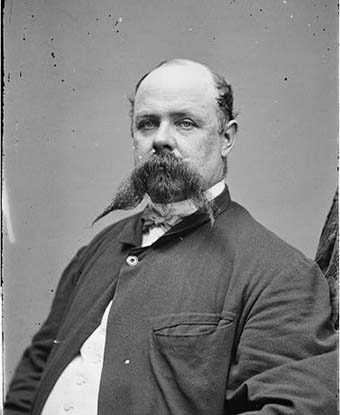Last updated: December 6, 2019
Person
Roswell S. Ripley

Library of Congress
Roswell Sabine Ripley, an officer in the US Army during the Mexican-American War, later received a commission as a brigadier general in the Confederate army. Ripley was born in Ohio, but his family later moved to New York. He graduated from the US Military Academy at West Point in 1843 from a class that also included future Civil War generals Ulysses S. Grant and William S. Rosecrans.
Lieutenant Ripley served on the staffs of General Zachary Taylor, future president, and General Gideon Pillow during the Mexican-American War. He saw combat in many battles: Monterey, Vera Cruz, Cerro Gordo, Contreras, Churubusco, Molino del Rey, Chapultepec, and the capture of Mexico City. Drawing from his extensive service, he wrote a two-volume history on the conflict. After serving in the Second Seminole War in Florida in 1849, he spent time with the Army on garrison duty. While stationed at Fort Moultrie on Sullivan’s Island, he met his future wife, Alicia Sparks. Having married a wealthy widow, Ripley resigned from the Army in 1853 and concentrated on managing his wife’s estates.
Ripley returned to Fort Moultrie under a new flag when he took command of the South Carolinians and later Confederates who occupied it, leading up to the Civil War. After taking part in the bombardment of Fort Sumter and overseeing South Carolina’s coastal defenses, Ripley transferred to a field command in Virginia in 1862. He commanded men during the Peninsula Campaign at the battles of Mechanicsville, Gaines Mill, and Malvern Hill. This campaign successfully defended the Confederate capital of Richmond, Virginia from Union General George McClellan’s army.
Ripley and his men followed that campaign with the invasion of Maryland under General Robert E. Lee's Army of Northern Virginia in the fall of 1862 at the battles of South Mountain and Antietam (or Sharpsburg) where he suffered a severe neck wound. Criticized for his performance at the Battle of Antietam, Ripley returned to Charleston where his artillery expertise could be put to effective use. Together again with his former commander at the outset of the war, General P.G.T. Beauregard, Ripley directed the successful defense of Charleston from an April 1863 Federal ironclad attack. Ripley stayed in Charleston, despite attempts to remove him from command because of interpersonal difficulties with his superiors, until the Confederacy evacuated in February 1865. He later fought under General Joseph E. Johnston at the Battle of Bentonville in March.
After the war, Ripley moved to England, residing there for twenty years. He returned to the United States in 1885, living in New York until his death in 1887. In accordance with his wishes, Ripley was buried in Magnolia Cemetery, in Charleston, South Carolina.
